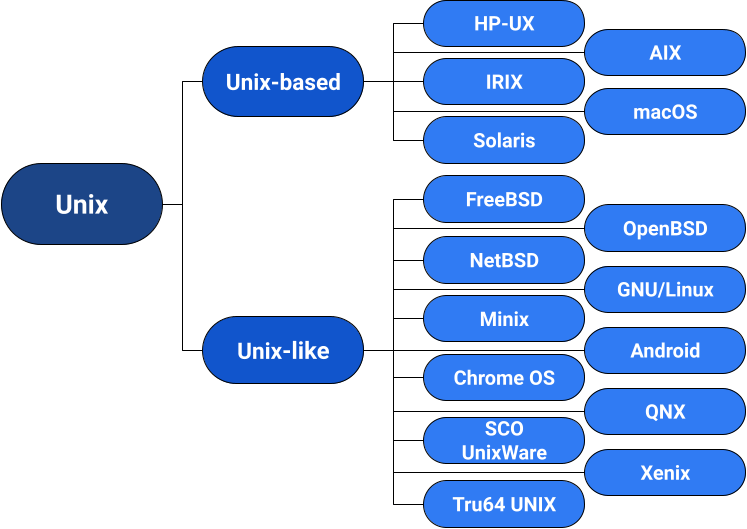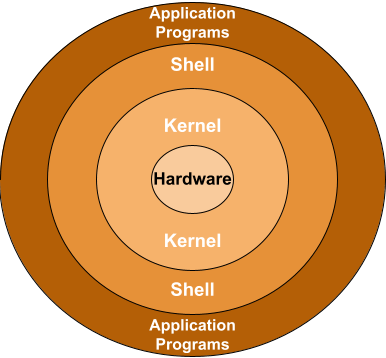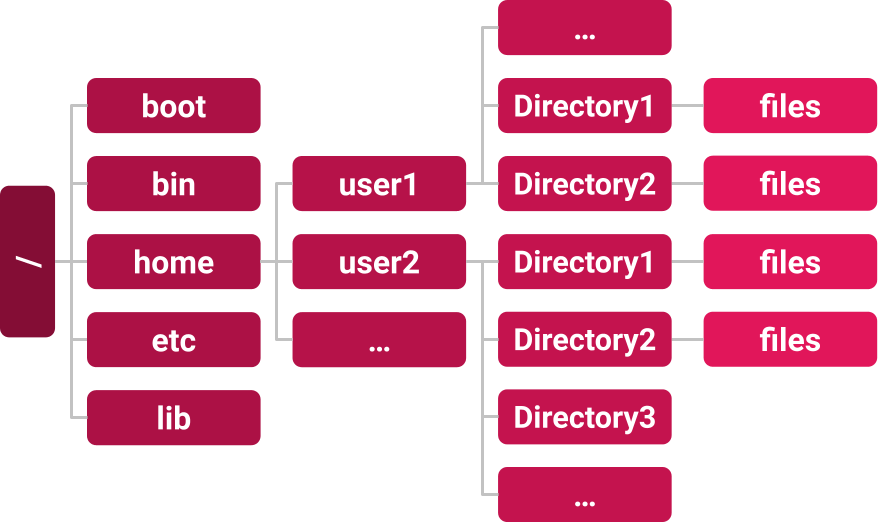FUNDAMENTALS A Complete Guide for Beginners

Operating System is a system software that manages computer hardware and software resources and provides common services for computer programs. Moreover, It controls all the other software and hardware that are installed on the machine. There are several types of operating systems, including Microsoft Windows, macOS, and various versions of Linux. A large portion of those operating systems belongs to the Unix family. In this article, you will learn what is Unix operating system, its functionalities as well as its usage.
What is Unix?
Unix (trademarked as UNIX) is an operating system (OS) that is one of the first OS developed using the C programming language. It is a multitasking, multi-user OS that provides a set of programs to act as a link between the computer and the user. The primary design philosophy of Unix is to offer simple yet powerful tools to perform complex tasks. It features a command-line interface allowing users to communicate with the system using commands than a Graphical User Interface (GUI).
History of Unix Operating System
A team of researchers including Ken Thompson, Dennis Ritchie, and Brian Kernighan developed Unix between the late 1960s and early 1970s at AT&T Bell Labs. The need for an operating system that could support multi-tasking and multi-user environments motivated developers to development of Unix. Because those qualities became increasingly important as computers grew more powerful and were used in larger organizations.
The first version of Unix was written in assembly language, but the developer then use the C programming language to rewrite the later versions, which made the operating system more portable and easier to maintain.
In the 1980s and 1990s, Unix became increasingly popular in academic and business environments, and many different versions of Unix were developed by various organizations. Some of the most popular versions of Unix include AIX, HP-UX, Solaris, macOS, Linux, and BSD.
Today, Unix continues to be used in various applications and environments. Again, some modern operating systems such as macOS, Linux, and Android have incorporated many of its principles and concepts.
Types of Unix Operating System
Unix is a family of operating systems. There are two branches of the OS, one is Unix based and the other is a Unix-like operating system.
A. Unix-based OS:
Mainly, the Unix-based OSs are derived from the original Unix Operating System, share some features and follow the principle of the original Unix. Unix-based operating systems have become popular because they offer many benefits of the original Unix operating system as well as some modern features such as graphical user interfaces (GNU), support for multimedia applications, support of VPN and firewall, etc.
B. Unix-like OS:
Unix-like operating systems are not necessarily derived from the original Unix operating system but mimic its behavior. The Unix-Like operating system includes some improvements that are available in the open source software (OSS). It shares many design principles and features of the original Unix operating system but not its proprietary code or specific implementations completely.
In the section below, I provide a list of the Operating system that belongs to the Unix family.
Unix Architecture
There are several layers in the Unix architecture. Those layers interact between the user and the computer hardware when using UNIX OS. The description of each layer structure in the Unix system is as follows:
A. Hardware
This layer contains all hardware-related information in the Unix environment. Hardware is the components that are humanly visible. CPU, memories and other physical components are examples of the hardware.
B. Kernel
The Kernel is the central component in the Unix system that acts as a bridge between the software and the hardware. It manages the system’s resources, such as the processor, memory, input/output devices, and networking components. This provides an interface for other software components to access the hardware resources of the system.
When the computer is turned on, the Kernel is loaded into the memory and remains there until the computer is turned off. While the computer is running the Kernel has access to all hardware resources of the system and other programs request access to the Kernel as they do not have direct access to the hardware resources.
C. Shell
A shell is a piece of software that offers a command-line interface for communicating with an operating system in computing. It is a user interface that enables input of instructions to carry out different operations, including the launching of applications, controlling of files, and running of scripts.
The shell receives the user’s input, which then interprets the instructions and calls the appropriate system utilities or programs to carry them out. It also gives the user a way to browse the file system, by displaying the current directory and enabling the user to switch to a different directory.
The shell is an essential component of most operating systems, including Unix, Linux, and macOS. The Command Prompt or PowerShell shell that comes with Windows also offers comparable features. Many shells also include features like history, tab completion, and scripting skills in addition to the command-line interface.
D. Application Programs
This is the outer layer of a Unix machine that executes the given external tasks such as creating and editing documents, managing files, and running scripts. Unix provides a wide range of application programs and the command line or a graphical user interface (GUI) can run those applications.
The Directory Structure of Unix
In the directory structure, each file is grouped with the others. The file system is set up in a hierarchical structure, like an inverted tree. Traditionally, the top of the hierarchy is called root (written with a slash /).
As you already know, Unix is a multi-user operating system so there may be multiple directories for different users under the home directory. Mainly the users’ directories store the information of different users and may organize it in different directories and files. In the following image, you can see the directory structure of the Unix operating system.
What is Unix Used for?
Unix is a powerful and versatile operating system used for a wide range of applications. Some most common usages of Unix are as below:
- Server applications such as server operating systems, powering web servers, file servers, email servers, and other types of servers.
- High-performance computing such as scientific and engineering applications requires significant computational power.
- Embedded systems such as routers, switches, and other networking equipment.
- Programming.
- Education: Unix is frequently used to teach operating system fundamentals, programming, and other computer science subjects in academic contexts.
- Desktop computing: Though Unix is not a commonly used operating system for desktop computing like windows and macOS, it is still used by some individuals and organizations as a desktop operating system.
Features of the UNIX Operating System
The Unix operating system offers a lot of features to its users. Some well-known features are as below:
- Unix’s unique set of features has made it a popular and powerful operating system for a wide range of applications. In the section below I have shortly discussed the features of the Unix operating system.
- Multi-User: Unix is a multi-user system that enables numerous users to operate simultaneously on the same workstation.
- Multitasking: The Unix operating system supports the simultaneous operation of many processes.
- Portability: The ability to run on a number of hardware platforms, such as servers, workstations, and personal computers, makes Unix
- Command-line interface: Unix provides a command-line interface that enables users to communicate with the system using a shell.
- File System: The hierarchical file system used by Unix arranges files and directories like a tree.
- Security: User authentication, permissions, and file encryption are the security features that make Unix renowned.
- Networking: Unix comes with built-in networking features that let computers connect to a network and share resources.
- Programming: A popular platform for software development because it includes a robust selection of development tools and compilers.
- Interoperability: A versatile and adaptable platform because it can operate with various operating systems and file systems.
Conclusion
The Unix operating system has played a significant role in the development of modern computing since the 1960s. Its modularity, flexibility, and security have made it popular for high-performance applications. Additionally, it served as an inspiration for the creation of Android, Linux, and macOS and is still a crucial part of the development of computers, and users can benefit from its flexibility and strength.
People Also Ask
What Exactly is Unix?
Unix is a family of multitasking, multi-user computer operating systems that is the base of many operating systems like Ubuntu, Solaris, Posix, etc. It was originally meant for programmers to develop software rather than non-programmers.
Is Unix a programming language?
No, Unix is not a programming language, it’s an Operating system. It is used to manage computer hardware and software resources and provides the foundation for running programs and applications.
What is a Unix-like operating system?
A Unix-like operating system is a computer operating system that shares many of the same features and design principles of the original Unix operating system but it’s not certified to any specific standard by the Open group.
What is the difference between the Unix OS and Unix-like OS?
The Unix OS refers to the original OS developed at the AT&T Bell labs meeting the specific standards and officially certified by the Open Group. On the other hand, Unix-like refers to the OS that emulates the functionalities, and interface of the original Unix OS. However, it lacks the license as the official Unix system.
What are the key features of a Unix system?
Some of the key features of the Unix operating system are:
- Multi-user support.
- Multitasking.
- Shell scripting.
- Security.
- Portability.
Is Unix still used today?
Yes. Unix remains relevant and still in use. Its derivatives like Linux and MacOS are prevalent across servers and supercomputers. Unix still is the foundation of many modern operating systems.
What is the current version of the Unix system?
The latest version of the Unix certification standard is UNIX V7, aligned with the Single UNIX Specification Version 4, 2018 edition.
Are there any Unix-based operating systems?
Absolutely. Several Operating systems are Unix-based such as Solaris, FreeBSD, Darwin, TRU64 Unix, HP UX, etc.
Similar Readings






